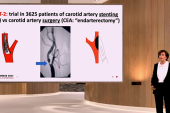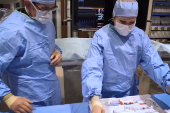Ticagrelor May Be an Option for Averting Brain Lesions During Carotid Stenting
The phase II trial missed its primary endpoint, but the P2Y12 inhibitor seemed to have some advantages over clopidogrel.

MUNICH, Germany—For patients undergoing carotid artery stenting, ticagrelor holds up well against clopidogrel for preventing ischemic brain lesions, and may even have some advantages, according to preliminary results of the phase II PRECISE-MRI trial.
On top of aspirin, ticagrelor didn’t significantly affect the proportion of patients with a least one new lesion on MRI compared with clopidogrel, but it was associated with a 37% reduction in the total number of lesions and a 70% reduction in total volume, Leo Bonati, MD (University Hospital Basel, Switzerland), reported last week at the European Stroke Organisation Conference (ESOC).
There were also fewer clinical strokes in the ticagrelor group, although the difference didn’t reach statistical significance.
The findings should be considered preliminary since MRIs were not available for about 10% of the study cohort at the time of this analysis, Bonati said. But, he added, “if confirmed in the full study population, then ticagrelor is a safe alternative to clopidogrel as add-on to aspirin to cover carotid artery stent procedures.”
Embolic stroke remains the major procedural complication associated with carotid stenting, Bonati noted, and optimizing antiplatelet therapy may help prevent some of those emboli from reaching the brain during the procedure.
Ticagrelor has shown advantages over clopidogrel in other settings—for reducing major cardiovascular events in ACS patients undergoing PCI and for preventing recurrent stroke in patients with minor stroke/TIA, for instance.
In PRECISE-MRI, conducted across 14 centers in Europe, investigators set out to compare the impact of the two P2Y12 inhibitors, both on top of aspirin, among symptomatic or asymptomatic patients with at least 50% carotid stenosis who were undergoing carotid stenting according to local guidelines. They excluded patients with atrial fibrillation and those who were taking antiplatelet therapy for any other reason.
Ultimately, 210 patients were randomized, less than the planned 370 due to slow recruitment and a lack of further funding, Bonati said. The primary safety analysis included 207 patients (mean age approximately 69 years; 31% women) after two patients withdrew consent and one was incorrectly randomized. Efficacy was assessed in a per-protocol population of 172 patients who initiated study medications and took the maintenance doses until at least the first follow-up MRI scan after stenting. Overall, more than half of patients (54%) were symptomatic, with prior stroke, TIA, or retinal ischemia, and most (86%) had a severe stenosis of 70% to 99%.
Antiplatelet therapy was started 1 to 3 days before stenting. Ticagrelor was administered with a loading dose of 180 mg followed by a twice-daily 90-mg maintenance for 1 month. Clopidogrel was given with a 300-mg loading dose followed by a once-daily 75-mg maintenance dose. All patients also received daily aspirin (100 mg).
The primary efficacy outcome was the presence of at least one new ischemic brain lesion on MRIs taken 1 to 3 days or 1 month after stenting. A numerically greater proportion of patients treated with clopidogrel versus ticagrelor had a new lesion, but the difference was not statistically significant (79.8% vs 74.7%; P = 0.43). The overall rate was “much higher than we had expected,” Bonati noted.
Ticagrelor was associated, however, with a lower total number of new lesions (median 2 vs 3; P = 0.027) and total volume of lesions (66 vs 91 µL; P = 0.030).
The composite clinical safety outcome included stroke, MI, major bleeding, and CV death, and this was nonsignificantly higher in the clopidogrel group (7.8% vs 2.9%; RR 0.36; 95% CI 0.08-1.20). Ten of the 11 safety events were ischemic strokes, with eight in the clopidogrel group and two in the ticagrelor group. There was also one MI in the ticagrelor group, but no major bleeds or vascular deaths in either arm.
Safety also was assessed using the presence of at least one new hemorrhagic brain lesion on either of the follow-up MRIs, and this did not differ between the clopidogrel and ticagrelor groups (47.6% vs 42.7%; RR 0.90; 95% CI 0.63-1.26). Most of the lesions were microbleeds ranging in size from 2 to 10 mm. There were no larger macrobleeds. Hemorrhagic transformation of the ischemic infarct tended to be higher in the clopidogrel group (17.9% vs 9.8%).
Commenting for TCTMD, Seemant Chaturvedi, MD (University of Maryland School of Medicine, Baltimore), said the go-to antiplatelet regimen during carotid stenting has typically been clopidogrel plus aspirin.
While the PRECISE-MRI results are interesting, “I don’t think it’s conclusive enough to say that you should shift to ticagrelor, but I think it gave sort of comfort that either regimen is acceptable,” he said.
Todd Neale is the Associate News Editor for TCTMD and a Senior Medical Journalist. He got his start in journalism at …
Read Full BioSources
Bonati L. Prevention of cerebral ischaemia in stent treatment for carotid artery stenosis. Presented at: ESOC 2023. May 25, 2023. Munich, Germany.
Disclosures
- PRECISE-MRI was funded by an unrestricted research grant from AstraZeneca.
- Chaturvedi reports being on the executive committee for the CREST-2 trial.





Comments